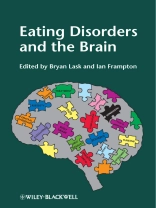Why is the brain important in eating disorders? This
ground-breaking new book describes how increasingly sophisticated
neuroscientific approaches are revealing much about the role of the
brain in eating disorders. Even more importantly, it
discusses how underlying brain abnormalities and dysfunction may
contribute to the development and help in the treatment of these
serious disorders.
* Neuropsychological studies show impairments in specific
cognitive functions, especially executive and visuo-spatial
skills.
* Neuroimaging studies show structural and functional
abnormalities, including cortical atrophy and neural circuit
abnormalities, the latter appearing to be playing a major part in
the development of anorexia nervosa.
* Neurochemistry studies show dysregulation within
neurotransmitter systems, with effects upon the modulation of
feeding, mood, anxiety, neuroendocrine control, metabolic rate,
sympathetic tone and temperature.
The first chapter, by an eating disorders clinician, explains
the importance of a neuroscience perspective for clinicians. This
is followed by an overview of the common eating disorders, then
chapters on what we know of them from studies of neuroimaging,
neuropsychology and neurochemistry. The mysterious phenomenon of
body image disturbance is then described and explained from a
neuroscience perspective. The next two chapters focus on
neuroscience models of eating disorders, the first offering an
overview and the second a new and comprehensive explanatory model
of anorexia nervosa. The following two chapters offer a clinical
perspective, with attention on the implications of a neuroscience
perspective for patients and their families, the second providing
details of clinical applications of neuroscience understanding. The
final chapter looks to the future.
This book succinctly reviews current knowledge about all these
aspects of eating disorder neuroscience and explores the
implications for treatment. It will be of great interest to
all clinicians (psychiatrists, psychologists, nurses, dieticians,
paediatricians, physicians, physiotherapists) working in eating
disorders, as well as to neuroscience researchers.
Cuprins
Preface xi
List of contributors xiii
Acknowledgements xv
1 Why clinicians should love neuroscience: the clinical relevance of contemporary knowledge 1
David Wood
1.1 Introduction 1
1.2 The legacy of mind-body dualism 2
1.3 Free will and determinism 3
1.4 Clinical implications 3
1.5 Restriction of energy intake and increase in energy output 4
1.6 Non-eating-related concerns 5
1.7 In-the-beginning questions: the problem of aetiology in eating disorders 6
1.8 The temporal, ‘vertical’ aetiological dimension 7
1.9 The spatial, ‘horizontal’ aetiological dimension 11
1.10 The importance of a neuroscientific aetiological framework 13
1.11 Conclusion 15
References 16
2 Eating disorders: an overview 19
Beth Watkins
2.1 Introduction 19
2.2 Clinical descriptions 20
2.3 Comorbidity 24
2.4 Epidemiology 25
2.5 Aetiology and risk factors 27
2.6 Treatment 35
2.7 Course and outcome 40
2.8 Conclusion 41
References 41
3 Neuroimaging 56
Tone Seim Fuglset and Ian Frampton
3.1 Introduction 56
3.2 Structural imaging 56
3.3 Functional imaging 90
3.4 Conclusion 101
References 101
4 Neuropsychology 106
Joanna E. Steinglass and Deborah R. Glasofer
4.1 Introduction 106
4.2 Intellectual functioning 107
4.3 Attention 108
4.4 Memory 110
4.5 Visuospatial processing 111
4.6 Executive functioning 113
4.7 Conclusion 116
References 117
5 Neurochemistry: the fabric of life and the fabric of eating disorders 122
Kenneth Nunn
5.1 Introduction 122
5.2 Five aims 122
5.3 Five propositions relating neurochemistry to the field of eating disorders 123
5.4 Five implications of these propositions 127
5.5 Five directions for future research 127
5.6 Conclusion 127
Acknowledgement 128
References 128
6 Body-image disturbance 129
Maria Øver°as
6.1 Introduction 129
6.2 What is body image? 130
6.3 How is body image constructed in the brain? 130
6.4 Body-image disturbance in eating disorders 133
6.5 The neuroscience of body-image distortion in anorexia nervosa 134
6.6 Conclusion 138
References 139
7 Conceptual models 142
Mark Rose and Ian Frampton
7.1 Introduction 142
7.2 Conceptual models in anorexia nervosa 143
7.3 Conclusion 161
References 163
8 Towards a comprehensive, causal and explanatory neuroscience model of anorexia nervosa 164
Kenneth Nunn, Bryan Lask and Ian Frampton
8.1 Introduction 164
8.2 The model 164
8.3 Critical appraisal 173
8.4 Clinical implications 175
8.5 Conclusion 177
Acknowledgements 177
References 177
9 Neurobiological models: implications for patients and families 180
Ilina Singh and Alina Wengaard
9.1 Introduction 180
9.2 The emergence of neurobiological models 180
9.3 Anorexia nervosa and illness representations 181
9.4 Impact of a neurobiological model on families’ understandings of anorexia nervosa 183
9.5 Conclusion 188
References 189
10 Implications for treatment 191
Camilla Lindvall and Bryan Lask
10.1 Introduction 191
10.2 Psychopharmacology 192
10.3 The educational context 193
10.4 Psychological treatment 194
10.5 Conclusion 205
References 205
11 Future directions 207
Ian Frampton and Bryan Lask
11.1 Introduction 207
11.2 Cause 207
11.3 Assessment and diagnosis 208
11.4 Treatment 210
11.5 Prevention 211
11.6 Future directions 212
11.7 Conclusion 215
References 216
Index 219
Despre autor
Bryan Lask FRCPsych, FAED, M.Phil, MB, . BS
Hon Consultant and Emeritus Professor of Child and Adolescent
Psychiatry, Great Ormond Street Hospital for Children, London, UK;
Research Director, Ellern Mede Service for Eating Disorders,
London, UK; Visiting Professor, Oslo University Hospital,
Norway
Ian Frampton BA(Hons) D.Clin.Psych. Dip.Clin.Neuropsych.
C Psychol.
Hon Consultant Psychologist, Great Ormond Street Hospital for
Children, London, UK; Visiting Research Consultant, Regional Eating
Disorders Service, Oslo University Hospital, Norway












